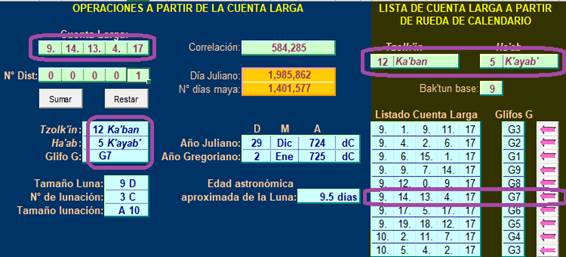


K&L.p65.G7.1 = MC.p50.G7.1 K&H.p51.TabVIII.7 Gronemeyer-GGF.p9.pdfp9.fig8.d
PNG Stela 3 Back B4

![]()

K&L.p65.G7.3 = Gronemeyer-GGF.p9.pdfp9.fig8.a K&L.p65.G7.4 = Gronemeyer-GGF.p9.pdfp9.fig8.b K&L.p65.G7.6 = Gronemeyer-GGF.p9.pdfp9.fig8.c
BPK Stela 2 A2 CPN Stela 5 AS5 PAL PT A15
Glyph-G:ma Glyph-G.ja Glyph-F[Glyph-G]


K&L.p65.G7.2 = MC.p50.G7.2 Gronemeyer-GGF.p9.pdfp9.fig8.e = Looper
QRG Stela D A8 QRG Stela D A15
Glyph-G Glyph-G Glyph-G
![]()

K&L.p65.G7.5 = Gronemeyer-GGF.p9.pdfp9.fig8.g = Graham
YAX Lintel 29 B4a YAX Lintel 29 B4a
Glyph-G Glyph-G.<Glyph-F>
· Distinguishing characteristic: NAAH + varying main sign.
· The Glyph-G7 of QRG Stela D is the same glyph-block in both Gronemeyer-GGF.p9.pdfp9.fig8.e and the Looper drawing, but using to different systems of glyph-block labelling (A8 in Gronemeyer-GGF.p9.pdfp9.fig8.e but A15 in the Looper drawing).
· Variants (3) of main sign:
o A. Representational:
§ Top: left fist viewed from back of hand. The fist is very common but optional – NAAH is the absolute diagnostic here.
§ Bottom: young man’s head with optional earspool – earspool can have three tassels (mnemonic: he’s seven times a “knucklehead”) – perhaps it’s a young woman’s head because:
· The forehead ornament of K&L.p65.G7.3 is often found on women.
· The infixed elements in K&L.p65.G7.2 resemble the “Female GI Title”.
If the head doesn’t have such a left fist above it, then there may be other syllabogram complements like ma or ja. In such cases, the head is not distinctly that of a young man.
o B. Abstract (stacked from top to bottom):
§ Short trifoliate element = tzi?.
§ lo.
§ Boulder with infixed crescent pointing up (reinforced walls and ceiling = “symmetric cave”).
§ na.
o C. NAAH-la.
§ The la is below the NAAH and is the simplest variant – the upside-down ajaw-face.
§ Dorota: Gloria in the scans p3 says it can also be NAL: glyph NAL or head variant of “2” (or something else).
§ The cases where there is a la at the bottom could be because of the NAL.
§ MHD transliterates a na-la and transcribes a naahal for BPK Stela 2 A2 and YAX Lintel 29 B4a.
· Do not confuse Glyph-G7 and the head variant of the numeral “2”:
o What they can have in common are (on the right):
§ Top: a left-hand fist with thumb pointing up.
§ Bottom: a youthful head.
o What distinguishes them (on the left):
§ Glyph-G7 has NAAH.
§ Numeral “2” has (or rather, can have) SAK.
These two will generally only occur in different contexts, so there should be no confusion. But “abstractly”, when thinking about “loose glyphs” out of context, it’s easy to confuse the two.
· There is a very strange variant K&L.p65.G7.7 = Gronemeyer-GGF.p9.pdfp9.fig8f, which has u instead of NAAH, and TIL:li which seems to have nothing to do with the other variants of Glyph-G7 – K&L describes it as Glyph-F[Glyph-G] (the 3-part element on the top of the right side is just the reduced variant of TI’, from Glyph-F):
|
|
|
|
|
K&L.p65.G7.7 = Gronemeyer-GGF.p9.pdfp9.fig8.f |
Looper (Coll-2) QRG Stela E West Side A6 |
Tolles A6 |
o This is probably because it’s incorrectly drawn. Examination of the Tolles photograph provided by MHD suggest that it could be Glyph-G8. In any case, not the TIL/TILIW proposed by GutiérrezGonzaléz-PhD.p146.pdfp159.
o It is almost definitely based on QRG Stela E West Side A6:
§ QRG Stela is a very tall monument, so it is hard to see the top part, where A6 is located.
§ The drawing by Looper of the stela itself shows that the middle of A6b is quite eroded and hence unclear – it doesn’t show a definite KAWAK with an arm on each side – this is additional interpretation in K&L and Gronemeyer-GGF. The Looper drawing suggests slightly that the middle element on the right is in fact HUUN, in particular, the “loop and tassels”, with the “loop” on the right and the two tassels on the left. The only aspect which is not HUUN-like is the middle, which looks more like a “cave” or “symmetric cave” (which isn’t present in HUUN).
§ Photographs (and logic) suggest that it is just a HUUN (being the middle part of Glyph-F), with something else, presumably an infixed Glyph-G in the middle of the HUUN.
§ It is tempting to read the infixed element in HUUN as HUL (the “floppy pear” of Glyph-G8), but calendrical calculations indicate that it should be Glyph-G7.
§ There are examples of HUUN where the middle part resembles a KAWAK (K&L.p28.#2.3) or LEM (K&L.p28.#2.1) – such instances could have been the source of the misreading of central part of the HUUN in the middle as KAWAK.
· Perhaps the u- is actually NAAH?
· Perhaps it’s the very eroded outline of the youthful human head very commonly seen for Glyph-G7?
These two “amendments” would make it totally a regular Glyph-G7 (infixed in Glyph-F).
§ In this context, the last element is li, which is used to indicate the intimate possession HUUN-li: u-ti’-huun-il (there are many other contexts where HUUN has the intimate possession ending) – this li further strengthened the misreading (and hence drawing) of this as TIL.

· The LC on QRG Stela E is 9.14.12.4.17, which has to be amended to 9.14.13.4.17 to give a CR of 12-Kaban 5-K’ayab.
· According to the calendar spreadsheet / program, this amended LC corresponds to Glyph-G7.


